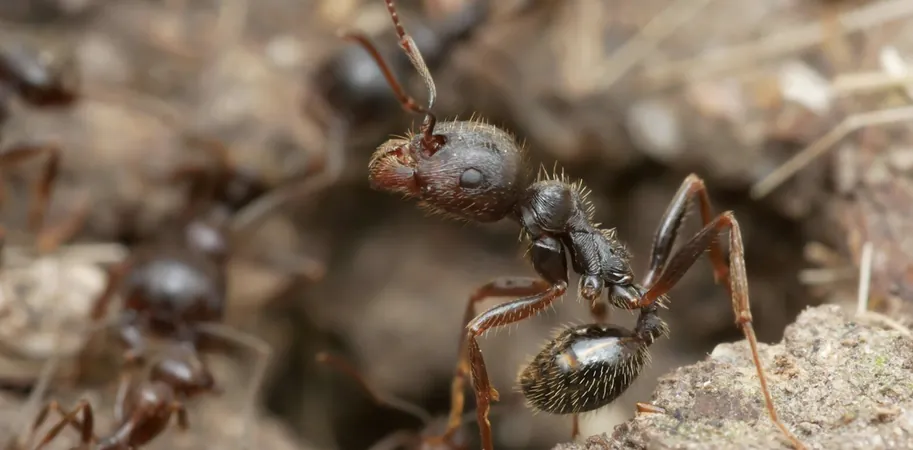
A Queen Ant's Shocking Secret: Parenting Two Species at Once!
2025-09-05
Author: Jia
The Ant Family Tree Just Got a Whole Lot Fancier!
Imagine a mother ant raising her kids from not one, but two distinct species! This isn’t a quirky concept; it’s a groundbreaking reality discovered in the insect world. A recent study published in *Nature* reveals that the queen of the Iberian harvester ant (Messor ibericus) lays eggs not only of her own species but also of the mysterious Messor structor.
Researchers have coined the term "xenoparity"—literally meaning 'foreign birth'—to describe this fascinating phenomenon. It challenges our traditional view of species boundaries and marks the first known instance of such a reproductive strategy in the animal kingdom!
Breaking the Rules of Reproduction!
Typically, in nature, a mother and father of the same species produce offspring of their kind. However, social insects—especially ants—often defy this norm. A study from 1999 even highlighted that 17 out of 164 ant species in central Europe can create hybrid offspring!
The typical reproduction method involves fertilized eggs becoming female workers and queens, while unfertilized eggs develop into male ants. The worker ants, which are the ones we usually see, are non-reproductive females that handle foraging and other duties.
A Unique Reproductive Strategy!
Interestingly, some ant species use a method called parthenogenesis, where unfertilized eggs transform into clones of their mother! This begs the question: what happens when different ant species share a colony?
From Hybrid Offspring to Cloning!
Fast forward to 2002, where the discovery of two seed harvester ant species in the Southwest US revealed queens that lost the ability to produce their own kind. To thrive, they need to mate with males from different species.
Now, let's connect the dots. The Iberian harvester queens are doing something similar. They can’t create worker ants alone; they require sperm from M. structor to produce daughters that are hybrids of both species!
Cloning in Action!
Even more intriguing, these queens also produce regular male ants of M. ibericus and M. structor. These males aren’t hybrids; they’re clones primarily carrying just their father's DNA—an incredible twist, as the queens essentially act like 'rental wombs'!
This cloning strategy is akin to what we see in some clams and stick insects, underscoring the adaptability of nature.
How Did This All Happen?
DNA sequences from hundreds of Iberian harvester ants consistently verified this unusual pattern of reproduction. The two species diverged from a common ancestor millions of years ago and exhibit significant differences in both appearance and behavior.
While M. ibericus thrives in various habitats from gardens to suburban areas, M. structor prefers mountain environments, creating unique ecosystems where the two can coexist.
The Future of Ant Evolution!
What could lead to such a radical reproduction strategy? It’s likely a phenomenon known as sperm parasitism, where females utilize the sperm of males from other species to trigger asexual reproduction.
Over time, these queens eliminated the need for full-fledged males, opting instead for their newly crafted clones within their colonies.
This astonishing adaptability showcases evolution's unpredictable nature. Forget the straight paths we often associate with natural processes—life can be much more intricate.
A Queen with Two Species, Just Like Your Family Tree!
So the next time you watch a line of ants bustling along, remember that in the enchanting realm of southern Europe, there’s a queen ant managing her unique two-species household. And if you think your family dynamics are complicated, imagine hers!



 Brasil (PT)
Brasil (PT)
 Canada (EN)
Canada (EN)
 Chile (ES)
Chile (ES)
 Česko (CS)
Česko (CS)
 대한민국 (KO)
대한민국 (KO)
 España (ES)
España (ES)
 France (FR)
France (FR)
 Hong Kong (EN)
Hong Kong (EN)
 Italia (IT)
Italia (IT)
 日本 (JA)
日本 (JA)
 Magyarország (HU)
Magyarország (HU)
 Norge (NO)
Norge (NO)
 Polska (PL)
Polska (PL)
 Schweiz (DE)
Schweiz (DE)
 Singapore (EN)
Singapore (EN)
 Sverige (SV)
Sverige (SV)
 Suomi (FI)
Suomi (FI)
 Türkiye (TR)
Türkiye (TR)
 الإمارات العربية المتحدة (AR)
الإمارات العربية المتحدة (AR)